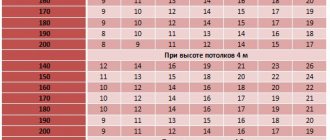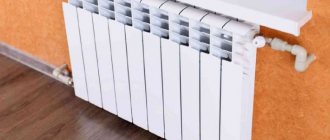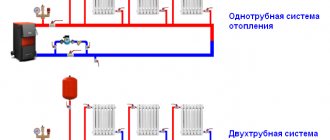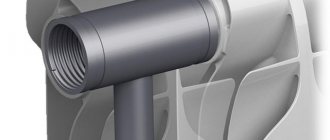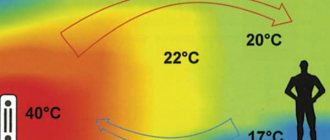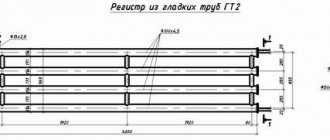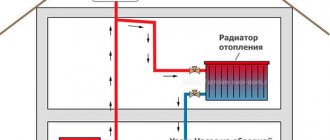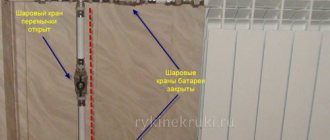Data preparation
To get an accurate result, the following parameters should be taken into account:
- climatic features of the region in which the building is located (humidity level, temperature fluctuations);
- building parameters (material used for construction, thickness and height of walls, number of external walls);
- size and types of windows to premises (residential, non-residential).
When calculating bimetallic heating radiators, 2 main values are taken as a basis: the thermal power of the battery section and the heat loss of the room. It must be remembered that most often the thermal power indicated by manufacturers in the technical data sheet of the product is the maximum value obtained under ideal conditions. The actual power of the battery installed indoors will be lower, so recalculation is done to obtain accurate data.
Basic calculation options
Now let’s figure out how to select the number of heating radiator sections for a particular room; there are many methods; we will consider only those that are easiest to implement and give a relatively accurate result.
Simplified technique
If you use this option, you need to be guided by the following principle: for a room in central Russia, located in a multi-story building, which has one external wall and one window, a thermal power of 100 W per m2 is required. In this case, the ceiling height should not exceed 2.8 meters.
A simple formula will allow you to easily carry out calculations
Let's look at a specific example, you only need to know how many m2 are in the room:
- Let's say we have a room with an area of 15 square meters with one window and one external wall, its ceiling height is 2.5 meters;
- For heating, cast iron radiators with a center distance of 50 mm will be used;
- Everything is very simple here: the number of radiator sections per 1 m2 is 1, that is, 15 sections are needed for 15 meters. Of course, if the coolant temperature in your system is 90 degrees, then the heat transfer from the batteries will be approximately 150 Watts, and 10 fins will be enough for you, but in practice such cases almost never happen; on average, the liquid heats up to only 70 degrees;
A cast iron radiator with 15 sections will allow you not to be afraid of even the most severe frosts
- If you have a corner room or a ceiling height of 3 meters or higher, then the result obtained must be multiplied by 1.2-1.3, depending on the quality of wall insulation and the type of window blocks used.
Important! In addition to all the above factors, the type of installation of radiators and the type of their connection also matters, so take these nuances into account and, if necessary, make adjustments to the final result.
This is how the connection options are arranged in order of preference, if the first two provide excellent efficiency, then in the third about 10% of the power is lost, and in the fourth even 15-20%
Using online calculators
The instructions for carrying out this type of calculation are also very simple; the most important thing is to find a quality resource with a good program that takes into account the maximum number of additional factors. This is the only way to guarantee that you will accurately determine how many square meters a particular radiator option will be enough for.
There are separate versions of programs for private houses
As for the calculations, they are simple:
- Enter all the requested data into the program fields , the more reliable and accurate they are, the better, because this affects the accuracy of the calculations;
- If there are no criteria in the calculator, then you simply multiply the result by a certain index (for example, the location of radiators is not always taken into account, but when determining how many radiator sections are needed, this factor cannot be overlooked).
As you can see, a lot depends on the installation option
Calculation based on volume
A very popular option due to the fact that it allows you to calculate the number of sections very accurately, some argue that the obtained value is overestimated, but it is better to install a radiator in 12 sections instead of the required 10 and use a regulator to maintain the desired temperature than install a radiator in 8 sections and at In extreme frosts, use additional heaters.
As for this technique, it is simple: you need to measure the actual length, width and height of the room and multiply the values together, the resulting result will be the volume in cubic meters. This value is multiplied by 41 - this is exactly how many watts are needed per cubic meter of air; with high-quality insulation and the use of energy-saving double-glazed windows, 34 watts per cubic meter is enough.
When making calculations, take into account the size of the heating radiator section; sometimes you have to install radiators lower than planned due to the characteristics of the room.
The higher the sections used, the greater their heat transfer
Some developers ask what to do if the calculation was made incorrectly and additional sections of heating radiators need to be installed? There can be two solutions - either add elements to an already installed structure (and its width should not be more than 16 ribs), or install a separate battery, it all depends on which option is easier to implement and better suits a particular room.
The simplest method
In this case, you will need to recalculate the number of installed batteries and rely on this data when replacing elements of the heating system. The difference between the heat transfer of bimetallic and cast iron batteries is not too big. In addition, over time, the heat transfer of the new radiator will decrease due to natural reasons (contamination of the internal surfaces of the battery), so if the old elements of the heating system coped with their task, the room was warm, you can use this data.
However, in order to reduce the cost of materials and eliminate the risk of the room freezing, it is worth using formulas that will allow you to calculate the sections quite accurately.
calculation of the number of sections of bimetallic radiators
We make calculations based on the volume of the room
For a panel house with a standard ceiling height, as mentioned above, the heat calculation is based on a requirement of 41 watts per 1 m3. But if the house is new, brick, double-glazed windows are installed in it, and the external walls are insulated, then you already need 34 watts per 1m3.
The formula for calculating the number of radiator sections is as follows: the volume (area multiplied by the ceiling height) is multiplied by 41 or 34 (depending on the type of house) and divided by the heat transfer of one radiator section indicated in the manufacturer’s passport.
For example:
Room area 18 m2, ceiling height 2.6 m. The house is a typical panel building. The heat output of one radiator section is 170 watts.
18X2.6X41/170=11.2. So, we need 11 radiator sections. This is provided that the room is not corner and does not have a balcony, otherwise it is better to install 12 sections.
Calculation by area
For each region of the country, there are SNiP standards, which stipulate the minimum power value of the heating device for each square meter of room area. To calculate the exact value according to this standard, you must determine the area of the existing room (a). To do this, the width of the room is multiplied by its length.
The power per square meter is taken into account. Most often it is 100 W.
Having determined the area of the room, the data must be multiplied by 100. The result is divided by the power of one section of the bimetallic radiator (b). This value must be looked at in the technical specifications of the device - depending on the model, the numbers may differ.
A ready-made formula into which you should substitute your own values: (a*100): b= required quantity.
Let's look at an example. Calculation for a room with an area of 20 m², while the power of one section of the selected radiator is 180 W.
We substitute the required values into the formula: (20*100)/180 = 11.1.
However, this formula for calculating heating by area can only be used when calculating values for a room whose ceiling height is less than 3 m. In addition, this method does not take into account heat loss through windows, and the thickness and quality of wall insulation are also not considered. To make the calculation more accurate, for the second and subsequent windows in the room you need to add 2 to 3 additional radiator sections to the final figure.
calculation of sections of bimetallic heating radiators by area
Calculation of the number of sections
To effectively heat your home in winter, you will definitely need heating radiators. When you need models that have good thermal conductivity and a long service life, it is better to immediately install cast iron batteries.
Radiators are made from cast iron alloy, which contains a high percentage of carbon. The metal turns out to be somewhat fragile (it is therefore not recommended to drop the batteries), but if installed correctly on the brackets, they can last for more than half a century without corrosive effects.
How to calculate the number of sections and power of cast iron batteries.
Cast iron radiators or, as many of us are used to calling them, batteries are still very popular among the population, thanks to their fairly affordable price and good heat dissipation. The main thing when installing them is to correctly calculate their weight and size. We determine the number of sections and the weight of the cast-iron battery before installing it. Before installing a cast-iron radiator in your home, you need to accurately determine its weight and the power with which its sections will operate. Moreover, when you calculate these parameters, in the first case you must proceed from the strength of the wall, and in the second - from the size of the room.
How to calculate the weight of a radiator section?
Determining the weight of a cast iron battery is quite easy. For older models, the weight of one section is approximately 7 kg. The cast iron radiator sections produced today are a little lighter. They weigh about 6 kg. Add 1.5 kg to this weight and you get the weight of the section filled with water. Now all you have to do is multiply this value by the number of sections in your radiator, and you will get its total mass. The mass of the entire battery filled with water should not exceed the maximum load that the wall in your home can withstand. The maximum permissible load on the walls is determined by the material from which they are made. You can find out the value of this indicator by contacting the housing department. To avoid cracks appearing on the walls, we recommend that you install more brackets for the radiator, or, if it is very heavy, even install it on the floor.
How many sections are needed to heat 1 m2?
The number of sections of a cast iron radiator is directly related to the size of the room in which it will be installed. If this is a room with ceilings up to 3 m high, then you should calculate its area, and then multiply the resulting number by 100 watts. The value you get will be an indicator of the radiator power required to heat the room. We divide it by 150 W - the average power value of the cast iron battery section. If the number you get is not a whole number, round it up.
To more accurately determine how many squares the battery section is capable of heating, the calculations should take into account the heat flow of the room:
- In a house built from panels, it is 40 W per m3;
- In a brick house - 34 W per m3;
- In rooms with high-quality thermal insulation - about 2 W per m3.
How to calculate the volume of a room?
If you take into account the heat flow of a room when calculating, then you need to calculate not its area, but its volume. You will need to multiply this volume by the heat flow rate, and then divide the resulting number by the section power equal to 160 W. If the ceiling height in the room is more than 3 m, you will also need to calculate its volume, but in this case all calculations are made taking into account the fact that 40 W of radiator power is needed to heat 1 m3 of air. If the room is corner, located on the first or last floor of a panel building, and also has more than one window, then the amount of power required to heat it must be multiplied by 1.2. It is not at all necessary that all the sections required to heat the room be combined into one radiator; you can divide their number into several small radiators and install them in different parts of the room. This way, you will reduce the load on the walls and reduce heat loss during heat distribution throughout the room. Before purchasing a radiator to heat your home, be sure to calculate how many sections it should have, because it is better to be on the safe side than to purchase a battery with insufficient power.
go to directory >>>
Calculation by volume
Calculation of the number of sections of bimetallic radiators using this method is carried out, taking into account not only the area, but also the height of the room.
Having received the exact volume, calculations are made. Power is calculated in m³. SNiP standards for this value are 41 W.
For example, we take the same values, but add the height of the walls - it will be 2.7 cm.
Let's find out the volume of the room (we multiply the already calculated area by the height of the walls): 20 * 2.7 = 54 m³.
Next, we determine the required battery power (we multiply the volume of the room by SNiP standards): 54*41 = 2214.
The next step is to calculate the exact number of sections based on this value (we divide the total power by the power of one section): 2214/180 = 12.3.
The final result differs from that obtained when calculating by area, so the method taking into account the volume of the room allows you to get a more accurate result.
Calculation methods
The most popular calculation methods are made using the actual area and volume of the heated room.
By area
Calculation by area is the simplest, but allows you to determine the number of sections only in apartments with a height of about 2.5 m. SNiP provides for a load per meter of 100 W. This is the standard for the middle zone. In the north beyond latitude 60, it can be significantly higher.
Multiplying the area by 100, we obtain the power of standard heat consumption. Dividing it by the rated heat transfer of the fin, we obtain the number of fins for heating.
By volume
Calculation by volume is used where ceilings are higher than 2.6 m. According to the standards, for heating cubic meters. Depending on the type of building, the following is required:
- for panel 41 W,
- for brick 34 W.
Multiplying the area by the height of the room we get the calculated volume in cubes.
By multiplying the number of cubic meters by the standard heat consumption of your home, we obtain the standard heat consumption power, which we use in the same way as in paragraph 2.1.
Heat transfer analysis of radiator sections
Despite the external similarity, the technical characteristics of radiators of the same type can differ significantly. The power of the section is affected by the type of material used to make the battery, the size of the section, the design of the device, and the thickness of the walls.
To simplify preliminary calculations, you can use the average number of radiator sections per 1 m², derived by SNiP: • cast iron can heat approximately 1.5 m²; • aluminum battery – 1.9 m²; • bimetallic – 1.8 m².
How can you use this data? From them you can calculate the approximate number of sections, knowing only the area of the room. To do this, the area of the room is divided by the specified indicator.
For a room of 20 m² you will need 11 sections (20/1.8 = 11.1). The result approximately coincides with that obtained by calculating the area of the room.
Calculation using this method can be carried out at the stage of drawing up an approximate estimate - this will help to roughly determine the costs of organizing the heating system. And more accurate formulas can be used when a specific radiator model is selected.
Calculation of the number of sections taking into account climatic conditions
The manufacturer indicates the thermal power value of one radiator section under optimal conditions. Climatic conditions, system pressure, boiler power and other parameters can significantly reduce its efficiency.
Therefore, when calculating, these parameters should be taken into account:
- If the room is corner, then the value calculated using any of the formulas should be multiplied by 1.3.
- For every second and subsequent windows you need to add 100 W, and for a door - 200 W.
- Each region has its own additional coefficient.
- When calculating the number of sections for installation in a private house, the resulting value is multiplied by 1.5. This is due to the presence of an unheated attic and the external walls of the building.
Calculator for calculating the number of sections of a cast iron radiator MS
Despite the wide range of modern heat exchange heating devices, the familiar cast iron “accordion” radiators are not at all going to go into oblivion. Moreover, manufacturers of such batteries do not experience any problems with sales. This is explained by the excellent reliability of products that can last for half a century or more, and high heat transfer rates.
Calculator for calculating the number of sections of a cast iron radiator MS
How to correctly determine the number of sections of such radiators in order to provide comfortable living conditions in the room? It all depends on the characteristics of the room where they are planned to be installed, and on the parameters of the batteries themselves - they can vary significantly. Our calculator for calculating the number of sections of an MS cast iron radiator will help you come to the right decision.
Prices for cast iron radiators
cast iron radiator
The calculation requires some explanation - they will be given below the calculator.
Calculator for calculating the number of sections of a cast iron radiator MS
Go to calculations
Explanations for calculations
The calculation algorithm is based on the fact that heating 10 m² requires 1 kW of thermal energy. It is clear that this ratio is very conditional, so it will be adjusted by a number of coefficients that take into account the specifics of the room.
- The area of the room is easy to calculate, especially if the room has a traditional rectangular configuration.
Help in calculating the area of premises of complex shapes
If the room has a more complex shape, then several different approaches can be taken. More details about this, with a consideration of possible examples and with calculation calculators, can be found in the article about calculating the area of premises .
- Number of external walls. The more there are, the more significant the heat loss, and this is taken into account by the calculation program.
- The location of the external walls of the room relative to the cardinal points is of considerable importance. The reason probably does not need to be explained.
- If the wall is located on the windward side relative to traditional winter winds, then it will cool down faster - therefore, a reserve of thermal power is needed to compensate for this phenomenon.
- “Frost level” characterizes the climatic features of the region. This column does not indicate anomalous temperatures, but rather normal temperatures for the coldest decade of winter.
- If the wall is fully insulated, based on the thermal calculations carried out, then the level of thermal insulation can be considered high quality. In general, uninsulated walls, in principle, should not even be considered, since heating will be a transfer of money to energy resources, and still a comfortable microclimate will not be achieved in the house.
- The higher the ceilings, the larger the volume of the room, and the more thermal energy is required to warm it up.
- The next two graphs take into account the vertical proximity of the room - above and below, that is, in fact, heat loss through the ceiling and floor.
- Next are several fields regarding the presence and features of windows. Naturally, the total need for thermal energy in the room to compensate for possible heat losses directly depends on these parameters.
- If the room has a constantly used door that goes out onto the street, into a cold entrance or onto an unheated balcony, then any opening of it is accompanied by an influx of cold air. This must be compensated for by a certain amount of power added.
- Features of a particular heating system may affect the pattern of inserting radiators into the circuit. And this, in turn, affects the heat transfer characteristics of the batteries. It is necessary to select the proposed insertion scheme from the examples presented.
- A radiator placed openly on the wall, hidden in a niche or covered with a casing - all of them will seriously differ in their heat transfer. This is taken into account in a special input field - you must select installation features from the list.
- Finally, the MS cast iron radiator models themselves differ in their linear parameters and, accordingly, in their specific thermal power per section. The proposed list presents the most common types of MS cast iron batteries, and their characteristics are already included in the calculation program.
- The result will show the recommended number of sections for installation in a particular room.
More information about cast iron radiators type MC
If you want to install these, although not of outstanding beauty, but highly reliable batteries, it is recommended to get to know them better. More details about cast iron radiators MS-140 and their “brothers” can be found in a special publication on our portal.
Battery power recalculation
In order to obtain the real, and not specified in the technical specifications for the heating device, power of the heating radiator section, it is necessary to make a recalculation, taking into account the existing external conditions.
To do this, first determine the temperature pressure of the heating system. If the supply turns out to be +70°C, and the output is 60°C, while the desired temperature maintained in the room should be about 23°C, it is necessary to calculate the system delta.
To do this, use the formula: the outlet temperature (60) is added to the inlet temperature (70), the resulting value is divided by 2, and the room temperature is subtracted (23). The result will be a temperature difference (42°C).
The desired value - delta - will be equal to 42°C. Using the table, they find out the coefficient (0.51), which is multiplied by the power specified by the manufacturer. They obtain the real power that the section will produce under given conditions.
| Delta | Coef. | Delta | Coef. | Delta | Coef. | Delta | Coef. | Delta | Coef. |
| 40 | 0,48 | 47 | 0,60 | 54 | 0,71 | 61 | 0,84 | 68 | 0,96 |
| 41 | 0,50 | 48 | 0,61 | 55 | 0,73 | 62 | 0,85 | 69 | 0,98 |
| 42 | 0,51 | 49 | 0,65 | 56 | 0,75 | 63 | 0,87 | 70 | 1 |
| 43 | 0,53 | 50 | 0,66 | 57 | 0,77 | 64 | 0,89 | 71 | 1,02 |
| 44 | 0,55 | 51 | 0,68 | 58 | 0,78 | 65 | 0,91 | 72 | 1,04 |
| 45 | 0,53 | 52 | 0,70 | 59 | 0,80 | 66 | 0,93 | 73 | 1,06 |
| 46 | 0,58 | 53 | 0,71 | 60 | 0,82 | 67 | 0,94 | 74/75 | 1,07/1,09 |
How to calculate the number of heating radiator sections for a room
There are several ways to make calculations, each of which uses certain parameters.
By room area
A preliminary calculation can be made based on the area of the room for which radiators are purchased. This is a very simple calculation and is suitable for rooms with low ceilings (2.40-2.60 m). According to building codes, heating will require 100 W of thermal power per square meter of room.
We calculate the amount of heat that will be needed for the entire room. To do this, we multiply the area by 100 W, i.e. for a room of 20 square meters. m, the calculated thermal power will be 2,000 W (20 sq. m * 100 W) or 2 kW.
Correct calculation of heating radiators is necessary to guarantee sufficient heat in the house
This result must be divided by the heat transfer of one section specified by the manufacturer. For example, if it is 170 W, then in our case the required number of radiator sections will be: 2,000 W/170 W = 11.76, i.e. 12, since the result should be rounded to a whole number. Rounding is usually done upward, but for rooms where heat loss is below average, such as the kitchen, you can round down.
It is imperative to take into account possible heat loss depending on the specific situation. Of course, a room with a balcony or located in the corner of a building loses heat faster. In this case, the calculated thermal power for the room should be increased by 20%. It is worth increasing the calculations by approximately 15-20% if you plan to hide the radiators behind the screen or mount them in a niche.
To make it more convenient for you to calculate online, we have made this calculator for you:
By volume
More accurate data can be obtained by calculating sections of heating radiators taking into account the height of the ceiling, i.e. by the volume of the room. The principle here is approximately the same as in the previous case. First, the total heat demand is calculated, then the number of radiator sections is calculated.
If the radiator is hidden by a screen, you need to increase the room's need for thermal energy by 15-20%
According to SNIP recommendations, 41 W of thermal power is required to heat each cubic meter of living space in a panel house. By multiplying the area of the room by the height of the ceiling, we get the total volume, which we multiply by this standard value. Apartments with modern double-glazed windows and external insulation will require less heat, only 34 W per cubic meter.
For example, let’s calculate the required amount of heat for a room of 20 square meters. m with a ceiling height of 3 meters. The volume of the room will be 60 cubic meters. m (20 sq. m*3 m). The calculated thermal power in this case will be equal to 2,460 W (60 cubic meters * 41 W).
How to calculate the number of heating radiators? To do this, you need to divide the obtained data by the heat transfer of one section indicated by the manufacturer. If we take, as in the previous example, 170 W, then for the room you will need: 2,460 W / 170 W = 14.47, i.e. 15 radiator sections.
Manufacturers tend to indicate overestimated heat transfer rates for their products, assuming that the coolant temperature in the system will be maximum. In real conditions, this requirement is rarely met, so you should focus on the minimum heat transfer rates of one section, which are reflected in the product data sheet. This will make the calculations more realistic and accurate.
If the room is non-standard
Unfortunately, not every apartment can be considered standard. This applies even more to private residential buildings. How to make calculations taking into account the individual conditions of their operation? To do this, you will need to take into account many different factors.
When calculating the number of heating sections, you need to take into account the height of the ceiling, the number and size of windows, the presence of wall insulation, etc.
The peculiarity of this method is that when calculating the required amount of heat, a number of coefficients are used that take into account the characteristics of a particular room that can affect its ability to store or release thermal energy.
The formula for calculations looks like this:
KT=100 W/sq. m* P*K1*K2*K3*K4*K5*K6*K7 , where
KT - the amount of heat required for a specific room; P - room area, sq. m; K1 - coefficient taking into account the glazing of window openings:
- for windows with conventional double glazing - 1.27;
- for windows with double glazing - 1.0;
- for windows with triple glazing - 0.85.
K2 - coefficient of thermal insulation of walls:
- low degree of thermal insulation - 1.27;
- good thermal insulation (two bricks or a layer of insulation) - 1.0;
- high degree of thermal insulation - 0.85.
K3 - ratio of window area to floor area in the room:
- 50% — 1,2;
- 40% — 1,1;
- 30% — 1,0;
- 20% — 0,9;
- 10% — 0,8.
K4 is a coefficient that allows you to take into account the average air temperature in the coldest week of the year:
- for -35 degrees - 1.5;
- for -25 degrees - 1.3;
- for -20 degrees - 1.1;
- for -15 degrees - 0.9;
- for -10 degrees - 0.7.
K5 - adjusts the heat demand taking into account the number of external walls:
- one wall—1.1;
- two walls—1.2;
- three walls—1.3;
- four walls—1.4.
K6 - taking into account the type of room located above:
- cold attic - 1.0;
- heated attic - 0.9;
- heated living space - 0.8
K7 - coefficient taking into account the height of the ceilings:
- at 2.5 m - 1.0;
- at 3.0 m - 1.05;
- at 3.5 m - 1.1;
- at 4.0 m - 1.15;
- at 4.5 m - 1.2.
All that remains is to divide the obtained result by the heat transfer value of one section of the radiator and round the resulting result to a whole number.
Expert opinion
Victor Kaploukhiy
Thanks to my varied hobbies, I write on various topics, but my favorites are engineering, technology and construction.
When installing new heating radiators, you can focus on how efficient the old heating system was. If its work satisfied you, it means that the heat transfer was optimal - these are the data that you should rely on in your calculations. First of all, you need to find on the Internet the value of the thermal efficiency of one section of the radiator that needs to be replaced. By multiplying the found value by the number of cells that made up the used battery, data is obtained on the amount of thermal energy that was sufficient for comfortable living. It is enough to divide the result obtained by the heat transfer of the new section (this information is indicated in the technical data sheet for the product), and you will receive accurate information about how many cells will be needed to install a radiator with the same thermal efficiency indicators. If previously the heating could not cope with heating the room, or, on the contrary, you had to open the windows due to constant heat, then the heat transfer of the new radiator is adjusted by adding or reducing the number of sections.
For example, previously you had a common cast iron battery MS-140 of 8 sections, which pleased you with its warmth, but was not aesthetically pleasing. Paying tribute to fashion, you decided to replace it with a branded bimetallic radiator, assembled from separate sections with a heat output of 200 W each. The rated power of a used heating device is 160 W, but over time, deposits have appeared on its walls, which reduce heat transfer by 10-15%. Therefore, the actual heat transfer of one section of the old radiator is about 140 W, and its total thermal power is 140 * 8 = 1120 W. Let's divide this number by the heat transfer of one bimetallic cell and get the number of sections of the new radiator: 1120 / 200 = 5.6 pcs. As you can see for yourself, in order to keep the heat transfer of the system at the same level, a bimetallic radiator of 6 sections will be sufficient.
Additional recommendations
To give batteries an aesthetic appearance, they are often masked with special screens or curtains. In this case, the heating device reduces heat transfer, and when calculating the required number of sections, another 10% is added to the final result. Since most modern radiator models have a certain number of sections, it is not always possible to select batteries taking into account the calculations performed. In this case, it is recommended to purchase a product whose number of sections is as close as possible to the desired one or slightly more than the calculated value.
